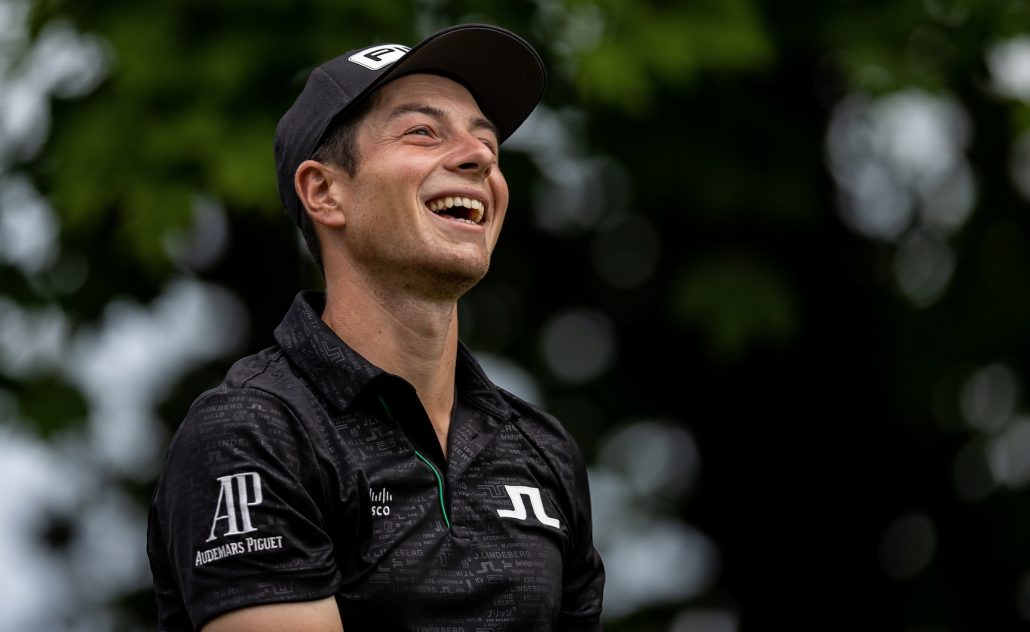Two years after turning professional, Norwegian Viktor Hovland has won three times on the PGA Tour and is living up to predictions.
When they turned professional in June 2019, Viktor Hovland, Matthew Wolff and Collin Morikawa were ranked 1st, 2nd and 3rd among the world’s amateurs. The trio represented the latest wave of youngsters entering the men’s professional game, at ages 21, 20 and 22.
Those watching from afar pulled their chairs a little closer to the TV.
They all came with glittering CVs, having dominated the amateurs and here they were, already wealthy, having signed lucrative equipment deals. Morikawa was quickest out of the blocks and went 22 starts without missing a halfway cut, something only Tiger Woods has bettered starting out as a pro.
Only two years have elapsed, but already Morikawa is a two-time Major champion and has reached a career-high No 2 in the World Ranking. Did we say he’s only 24?
Wolff has won ‘only’ once on the PGA Tour, the 3M Open where he beat Bryson DeChambeau and Morikawa a month after turning pro, while his best finish at a Major is second, behind DeChambeau and ahead of Louis Oosthuizen, at the 2020 US Open. He’s around 31 in the world after reaching a career-high No 12. Yes, he’s only 22.
And Hovland? He’s also only 24, with three PGA Tour wins, one of which, the World Wide Technology Championship at Mayakoba, nudged him into the world’s top 10 for the first time.
Incredible records already from the three known as the Holy Trinity.
Morikawa and Hovland also played at the latest Ryder Cup, where Morikawa sank the putt that mathematically clinched the title for the United States. Wolff missed out on selection for Whistling Straits but his time will come.
So, as we reach the end of 2021, have they lived up to the hype? With two Majors, eight PGA Tour victories and one European Tour win among them, the answer is a resounding yes.
‘The fact those three guys have won already is unbelievable. They probably don’t even realise how impressive it is,’ former world No 1 Justin Thomas said last year. ‘They understand how talented they are, and we do too, and they’re going to be out here for a long time.’
Wolff won in his third start as a pro and reflected at the time, ‘What we did is pretty unbelievable. You’ve seen it happen before, but to have three guys come and use their sponsor exemptions in the same year to get their PGA Tour card right off the bat, that is pretty exceptional.’
In those first few months after turning professional, Hovland set a PGA Tour record in the opening round of The CJ Cup in Jeju, South Korea, when he shot three-under-par 69s in the opening two rounds. He had beaten the 17-round streak of consecutive scores in the 60s, set by Bob Estes in 2001, by two.
Hovland is strapped in for the long run as a professional. After his exploits at the 2013 European team championship aged 13, he caught the eye of Alan Bratton, head coach of Oklahoma State University. ‘I went to watch another Norwegian, Kristoffer Ventura, but I saw Viktor and really liked him,’ Bratton recalls. ‘He was the team’s fourth-best player. I saw something special.’
Bratton spoke of Hovland’s regular use of technology to set himself apart. ‘Viktor is incredibly knowledgeable about the golf swing,’ he said. ‘Being in Norway he didn’t have the same opportunities as players in the States, so he spent lots of time online. He sent videos of swings to instructors and a lot was just for his own learning. I don’t think he will ever stop that pursuit of perfection.’
Hovland learned to swing from instructions on the internet. He hit balls in a soccer field near his house. Although he played soccer and did taekwondo, he began to focus on golf at 11 or 12. He found coaches, practised hard and shot 26 under to win the Norwegian Boys Championship at 16.
Bratton was struck by Hovland’s confidence after the Norwegian adopted a different swing at his first European Tour event. ‘He played the first round pausing at the top of his swing. He had done it as a drill but never on the course. I remember he shot 68 and had a bogey-free round. My phone blew up with people saying, “What’s Viktor doing with his backswing?” I called him and asked, “How long have you been doing that?”
He said, “Since this morning.” That was a big deal. His first European Tour event and he wasn’t afraid to try something completely new.’
As a junior Hovland was a bit ‘round’. Today he’s a chiselled 1.78m with a powerful lower body.
‘I’ve been trying to get stronger for a year,’ he told PGATOUR.com. ‘I think the lower body is just more genetic; you know, my mom is from Russia, so I’ve got some Russian genes in there. We’re not like most Scandinavians, who are tall and skinny. We’re shorter and stockier.’
In fact, Hovland and his Norwegian teammate, Kristian Johannessen, shared an engaging pre-event media conference at the Tokyo 2020 Olympics.
‘I first met him at about 13 or 14 and he came up like, yeah, a fat little kid and started to play really well.’
Hovland, though, is known for having a light-hearted demeanour, no matter how serious and steely-faced he can be out on the golf course.
At the Shriners Hospital Children’s Open, the PGA Tour Live crew was infatuated by his seemingly new ‘beefed-up’ physical look. ‘You think we’re seeing a bit more chest muscle here on Viktor?’ one of the announcers asked. ‘He’s been hitting the weights a little bit?’
‘That, or just showing off maybe,’ replied another broadcaster. ‘His back is a little bit more defined, isn’t it?’ So, they did what live streaming demands. They asked him directly. ‘It’s the JL shirt.
I call it the auto-jack shirt, they just fit around the arms so they look huge, even though they’re really small. But I have been working out a little bit [laughs].’
Hovland’s instructor is Jeff Smith, a former professional poker player who was based in Las Vegas. They talk mostly golf, but poker comes into their discussions, too.
‘The No 1 skill in poker is to process a lot of information in a short period of time, and Viktor can do that,’ he told PGATOUR.com. ‘He could become a world-class poker player in time. He’s analytical. A lot of people ask questions and don’t really want to know the answer. He wants the truth about why something works a certain way. Sometimes he’ll ask a question he knows the answer to; he will keep you on your toes as an instructor.’
Smith feels that Hovland’s driving is one of the main keys to his success.
‘He’s one of the best drivers of the ball in the world. He knows it’s a weapon and he can take more risk there because he has what we call an equity advantage over the field.
‘If you want to be one of the best in the world, you must somehow gain one and a half strokes a round, total, on the field. Viktor gains 0.7 strokes off the tee, so he’s already halfway there with the driver. I don’t think there are 10 people on Tour who average 300-plus yards off the tee and hit 60% of the fairways.’
And so the journey continues. The good just keep getting better.
20 BEST FINISHES
2019: Wyndham Championship (4th), US Open (T12th), Boise Open (T2nd), BMW PGA Championship (T11th)
2020: Mayakoba Golf Classic (1st), Workday Charity Open (T3rd), Puerto Rico Open (1st), DP World Tour Championship (T3rd), US Open (T13th), The CJ Cup (T12th)
2021: World Wide Technology Championship at Mayakoba (1st), WGC-Workday Championship
(T2nd), BMW International Open (1st), Wells Fargo Championship (T3rd), Farmers Insurance Open (T2nd), Valspar Championship (T3rd), Tour Championship (T4th), Genesis Invitational (T5th), The Open Championship (T12th), Saudi International (T6th)
– This article first appeared in the December 2021 issue of Compleat Golfer magazine. Subscribe here!









